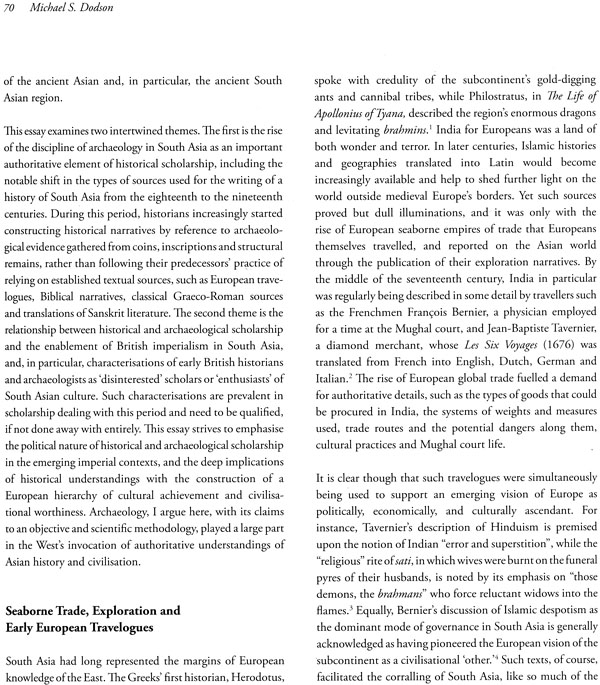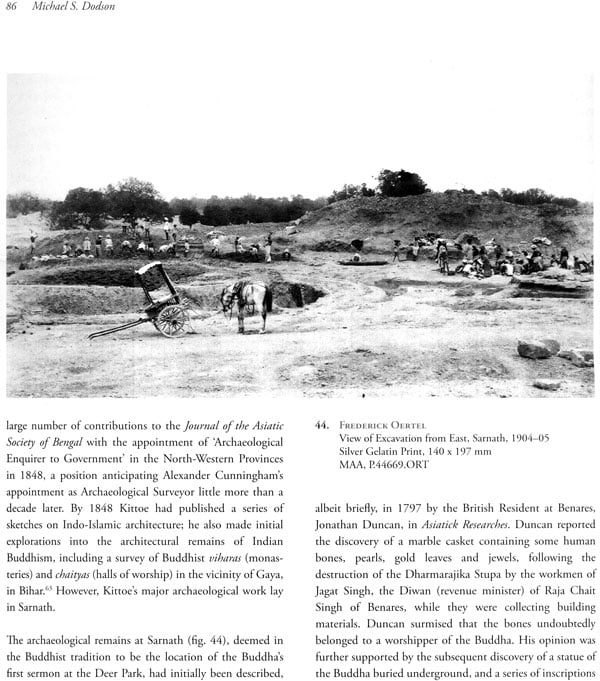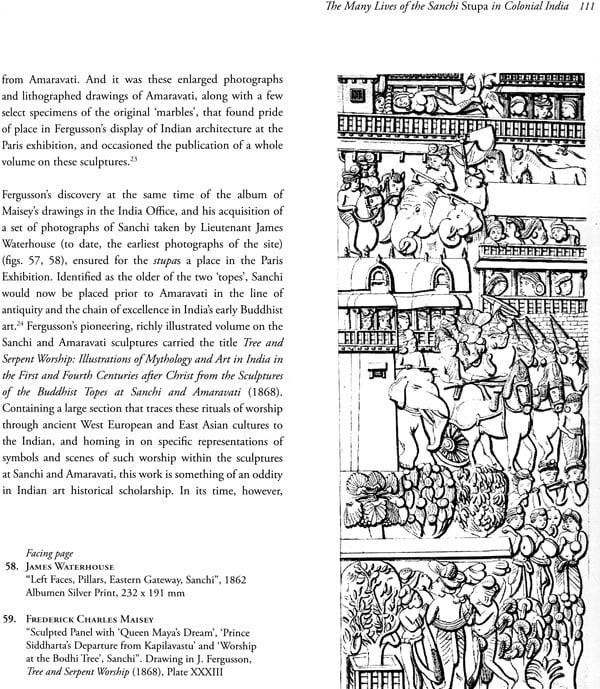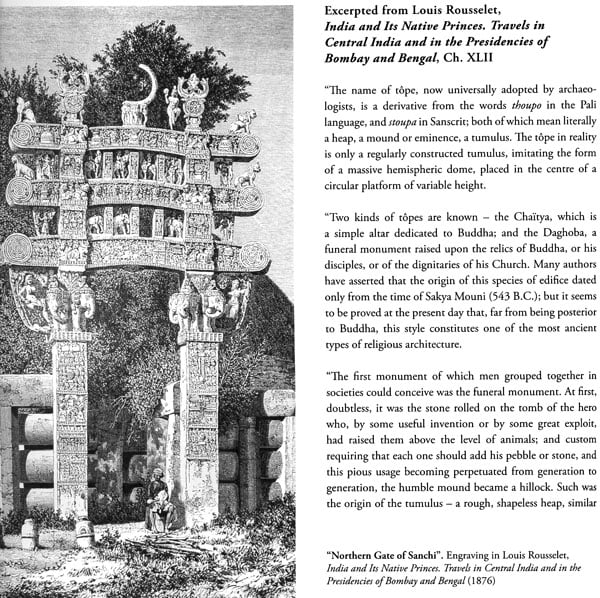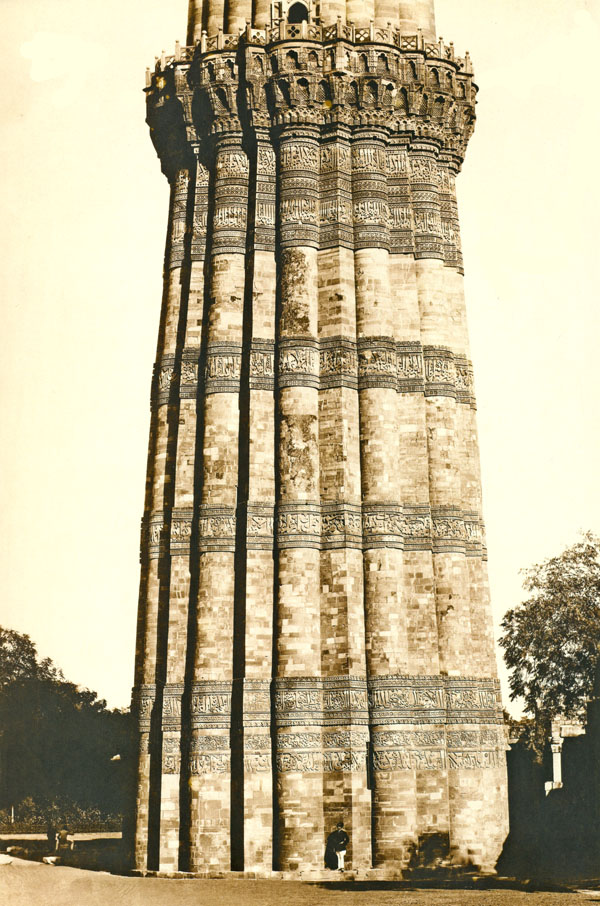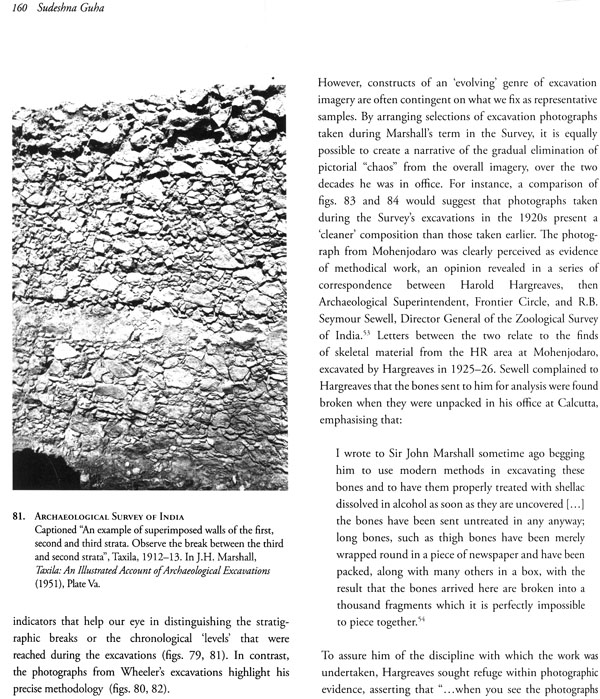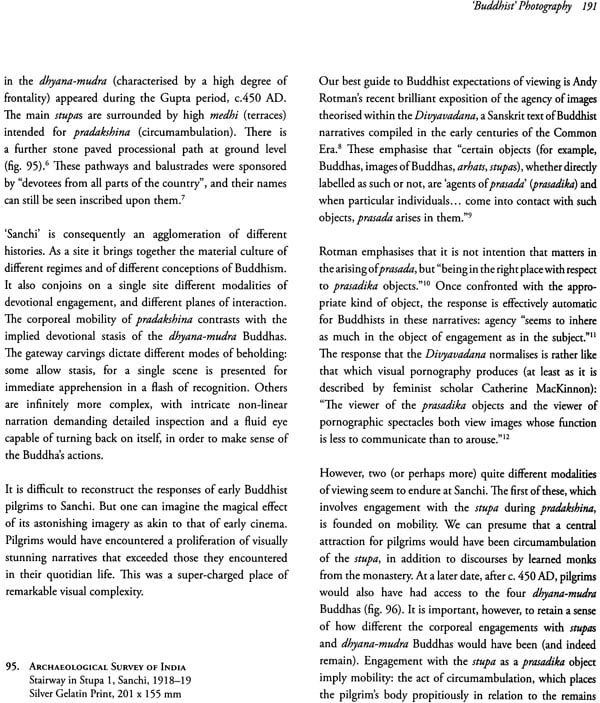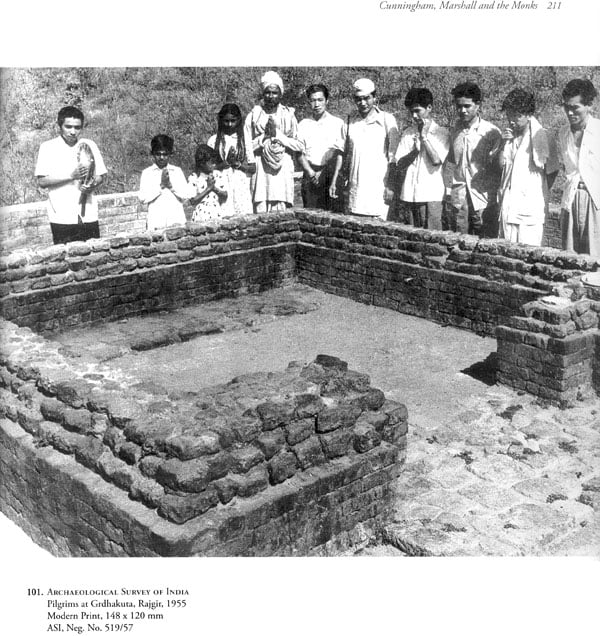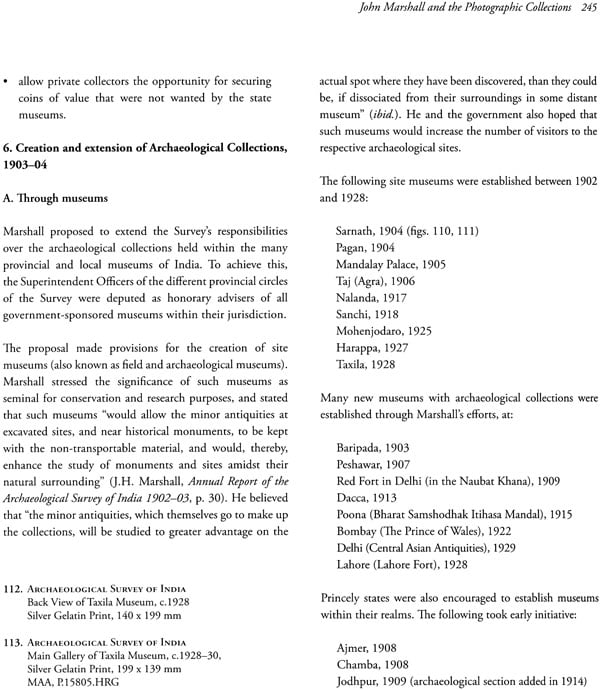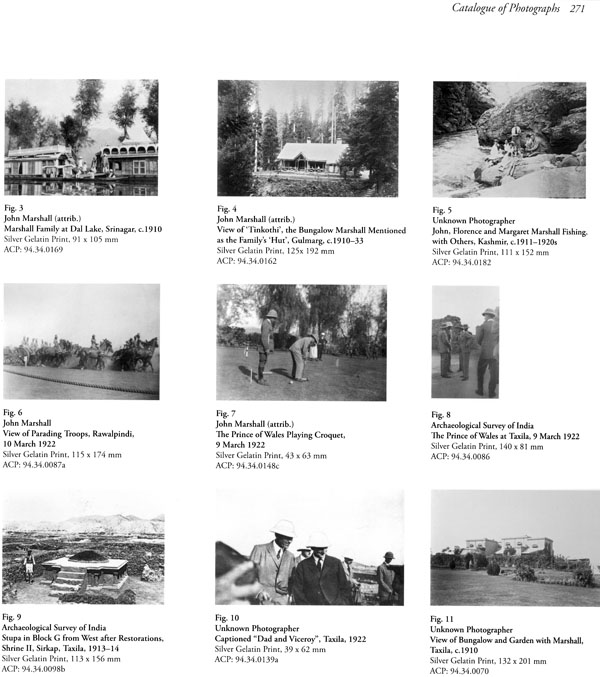
The Marshall Albums: The Alkazi Collection of Photography (Photography and Archaeology)
Book Specification
| Item Code: | NAF645 |
| Author: | Sudeshna Guha |
| Publisher: | Mapin Publishing Pvt. Ltd. |
| Language: | English |
| Edition: | 2010 |
| ISBN: | 9781890206451 |
| Pages: | 228 (Throughout Color Illustrations) |
| Cover: | Hardcover |
| Other Details | 11.0 inch x10.0 inch |
| Weight | 1.99 kg |
Book Description
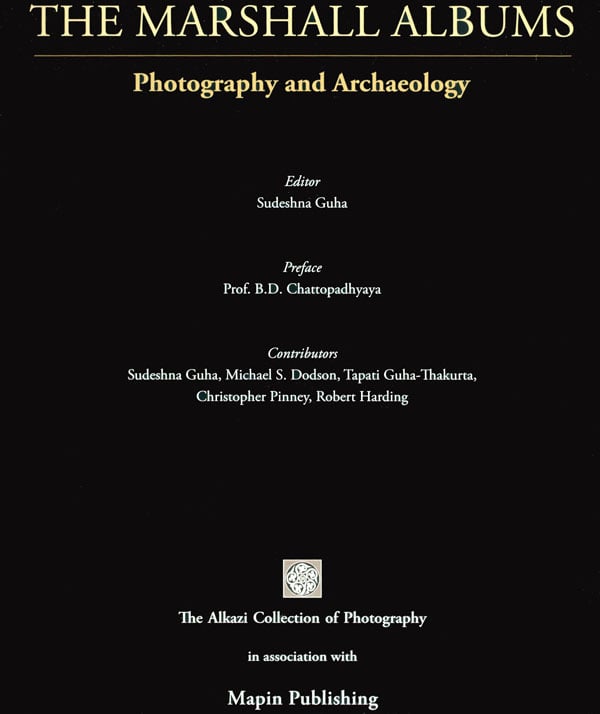
Drawing mainly on the photographic albums in the personal collection of Sir John Marshall, one of the most reputed British archaeologist of India and the longest serving Director-General of the Archaeological Survey of India, this volume explores some of the civilization histories of ‘ancient India’ that were founded through archaeological fieldwork and its photography. While maintaining focus on Marshall’s contributions to South Asian archaeology, it encourages a critical review of archaeology’s emergence as an authoritative science in ht e writing of India’s history, and the agency of photographs I establishing parameters of archaeological field research. By engaging with the physicality of scope and evidential regimes the contributors also showcase the diverse manifestations, and inevitable uses, of archaeological practices within British India.
About the Author
Sudeshna Guha is Affiliate Lecturer in South Asian History at the Faculty of Asian and Middle Eastern Studies in Deccan College, Pune, and has created the photographic collections of the Museum of Archaeology and Anthropology (Cambridge) for over eight years. She researches on notions of historical evidence through histories of archaeology and photography.
My none –too- meager collection of amateur snapshots, taken at a variety of sites, has always been regarded with amused indulgence by my family; in their eyes, my photographic ventures fall far short of expected technical and aesthetic standards. I cannot claim to be a technically sophisticated field archaeologist either.
I was therefore both surprised and delighted to receive an invitation to write a Foreword to this sumptuous volume of historical images accompanied by detailed textual analyses. I was very pleased to oblige; in addition, it was too tempting an opportunity to vindicate my interest in Photography to skeptical viewers at home.
As a teacher and researcher in the field of ancient Indian history, I have always relied upon photographic material in order to develop my work. India offers an amazingly unique chronologically diverse spectrum of relics of the past, and the scope of archaeological photography has therefore always been extremely rich. The sheer volume of what is available today is simply staggering. Only a fraction of the material excavated and documented by the Archaeological Survey of India (ASI) prior to Independence was used as visuals in publications of the time; and though the photo archives of the ASI remain a veritable, but sadly neglected, trove of pre-and post-Independence archaeological photographs, on tends to doubt now whether everything that was collected has been retained. I personally do not know whether pre-Partition archaeological photographs are part of institutionalized departments of archaeology in Pakistan and Bangladesh.
The bulk of the photographs in this volume are sourced from the Marshall Albums in The Alkazi Collection of Photography. Visuals have also been taken from the 60 volumes of Marshall albums now divided into two parts under the custodianship of the universities of Cambridge and Durham. Additionally, there are photographs taken from other albums, museum collections and during the tenure of some of Marshall’s predecessors at the ASI. Initially appointed for a period of five years, Marshall had a long tenure at the ASI, first as its Director General (1902-1928) and then as Officer on Special Duty (1928-1934). During his management, the corpus o collected material and its photographic documentation grew enormously.
From a historiography point of view, since there was a general scarcity of authentic c written sources, objects fashioned by the “chisels of the country’s ancient sculptors were immeasurably more to be trusted than t he pens o f her authors”, as has been remarked. But what were the various and particular implications of photography within the demanding discipline of colonial archaeology? Since renderings of he photographed object inevitably altered over time with changes in technology and visual modalities in general, were there specific concerns relating to the manner of imaging of selected archaeological items?
Of course, the particular interests of individuals heading the ASI, or of those associated with it, may have varied considerably. In his pioneering tour reports covering an extensive area of north, central and other regions of India, Alexander Cunningham expressed his desire for an “accurate description of sites visited and excavated through illustration, plan, and photograph”-the latter being one of the techniques by which description” could be achieved. Marashall’s own preference was perhaps for the ‘artistic’. In his introduction to the Annual report of the Archaeological Survey of India 1902-03, the newly appointed Director General offered an apology for “possible unevenness of language and presentation in the Reports in terms of different authorship “, adding that “pictorial illustrations, the reproductions, the plans and the sketches”, prepared at different places and “therefore of unequal qualities” were not to be viewed a s “single artistic whole”.
Marshall may have relinquished this initially apologetic position over the years through his forceful and positive personal interventions at archaeological sites, making them more accessible to visitors and photographers. His overall preference for the picturesque and the panoramic, with ‘natives’ strategically placed to highlight the scale of architecture and landscape , was certainly different from the austere, orderly mode of R.E.M. Wheeler, the important colonial archaeologist who had attempted to give a new direction to archaeology in the subcontinent. Regardless of methodological differences, however, a fundamental question remained: was there an overarching/underlying ideological theme manifesting through archaeological photographs, now assuming significance as a crucial modality of visual representation?
In his Annual Report of 1902-03, Marshall explained that “current archaeological operations”. Which during the initial years of his directorship rested on shaky foundations, related “ first and principally to Conservation, secondly to Exploration and Research, and lastly to Epigraphy.. its [the Survey’s] duty will therefore be to pace before European Scholars for elucidation rather than to attempt elucidation on its own account”. Evidently it did not matter to the British administration that a number of Indian scholars were then engaged in studies of archaeology and its various branches, and that alternative historiographies were being conceived for connecting the past and the present as a nationalist agenda. All archaeological material was to be prepared, in the form of reports and visuals, for interpretation-and canonization-by Europeans.
The meticulously researched analyses and critical narratives in this volume remain sensitive to colonial intent and methodology, even as they focus on the complexities of decoding the elusive yet enduring themes embedded in archaeological photographs. They suggest that historical images are neither disciplinary constructs nor self-revelatory truths; rather, they are equivocal objects that resist fixed frames and predictable trajectories. Ultimately, the responsibility for ‘meaning’ devolves upon the viewer, for photographs are no more –and no less than what we make them out to be.
During their formative years in the nineteenth century, archaeology and photography made substantive contributions to the historical method. Perceived as field practices capable of rendering fairly objective accounts, the authority that was invested to both derived from the understanding that they allowed reality to be ‘captured’ in an unmediated fashion, and offered a relatively objective means of documentation. However, the knowledge that was established through archaeological investigation and its photographs also acquired, many different values through their diverse usages. The five chapters in this volume present analyses of this phenomenon through an exploration of the histories of early India that were archaeologically created during British rule of South Asia. They offer seminal references for archaeology’s emergence as an authoritative science and photography’s agency within the construction of historical narratives of India’s pre-colonial past.
One objective of this volume is to draw attention to the ways in which historical evidence is often negotiated and fixed as irrefutable fact through archaeological work. The other is to create an awareness of the materiality of vision and the ways in which photography, photographs and photographic collections are used for establishing disciplinary epistemologies and archaeological knowledge. The intention here is to demonstrate that neither the historical realities that are archaeologically established nor their photographic representations can be assured for perpetuity as phenomena with ‘fixed’ meanings.
The volume derives inspiration from a personal collection of photographs of, perhaps, the most reputed British archaeologist of India, Sir John Marshall, who was also the longest serving Director General of the Archaeological Survey of India(1902-28). The Survey was newly reinstituted in 1902 with Marshall as its head. His appointment was spearheaded by the Viceroy of India, Lord Curzon (1899-1905), who wished to enhance the ‘merits’ of his government’s rule by adding to its visibility through archaeological excavations and restorations of India’s monumental heritage. At the age of 26, and with no experience of India in terms of either scholarship or previous visitors marshal was brought from England to head archaeological projects within British India.
The Archaeological Survey of India had a long and chequered past. First established in 1861, just three years after Britain had formally acquired India, the Survey initially had only an Archaeological Surveyor as its staff. This ‘organization’ was disbanded in 1866, when the Surveyor ( who in effect was the Director), Alexander Cunningham, completed what he reckoned were four ‘intensive’ archaeological surveys of the Upper Gangetic plain of northern India. The survey was reinstituted in 1871 with Cunningham now designated as Director General (187 1-85).
The colonial will to preserve India’s monumental heritage emanated from the field surveys of its historic architecture and their subsequent ‘listing’. Embarked upon, albeit in a desultory fashion, from as early as 1847 by the East India Company, such architectural surveys of India became an essential aspect of ‘architectural surveys of India became an essential aspect of ‘archaeological ‘ documentation, and remained integral to the archaeological work that was undertaken by Marshall’s Survey. The documentations were often accomplished through detailed photography, and one of the most enduring aspects of the nineteenth-century archaeological projects within India are the extensive collections of architectural photographs and drawings, the bulk of which at present are in the British Library in London. The British Raj officially proclaimed d the restoration of India’s monuments as its ‘enlightened duty’ in 1878, and intimated a short lived curatorial responsibility, between 1881 and 1883, for preserving the historical heritage of its native subjects.
As a centralized institution, the Archaeological Survey of India ceased to exist in 1889 with the tenure of its second Director General, the architectural historian James Burgess (1885-1889). Marshall’s appointment in 1902 heralded its reinstitution, but with an extensive reorganization of its administration. Although like its nineteenth-century counterparts this ‘new’ Survey was conceived as a temporary organization with a life span of five years, it was mandated with a focused work plan and give ‘headquarters’ at Simla in the Gorton Castle Secretariat .
The Proposals for the Archaeological Survey of India’s redevelopment, which were implemented in 190, also included plans for the creation of unique collections and archives of books, photographs and administrative records. The Central Archaeological Library and the Photographic Collection of the DGA (Director General of Archaeology), instituted in 1903 and 1904 respectively at Marshall’s behest, together with the Survey’s documentary archives developed at its headquarters from 1902, have come to represent the three most valuable resources for the early-twentieth-century history of archaeological practices within India and Burma. The official archives remain a distinguishing aspect of Marshall’s administration of Indian archaeology (see Appendix A, Part II, Section 6 in this volume). This volume, which draws on the Survey’s archives to a considerable extent, hopes to create an awareness of their value as historic sources and the urgency of preserving them. At present both the library and the documentary and photographic archives in New Delhi are in a precarious state, and the Survey’s continued neglect of their proper conservation will only lead to their proper conservation will only lead to their premature extinction.
Mindful of the many recent publications on the nineteenth and early-twentieth-century history of Indian archaeology and British archaeologists of colonial India, including Marshall, a conscious effort has been made here to abstain from narrative histories of South Asian archaeology. Instead, a thematic and chronological space that extends beyond Marshall and his times is reviewed, to explore the ways in which we can analyse relationships between archaeological evidence and its representation, critique the propagation of ‘scientific archaeology’ for nurturing partisan politics, and explore the importance of receiving monuments, antiquities and their photographs as socially salient objects.
This introduction sets the referential frame for the chapters that follow by providing an overview of the politics, relationships and collaborations through which Marshall directed the archaeology of India, and strengthened the position of the Survey. It also offers a glimpse of his conservation efforts, not detailed elsewhere within the volume, through photographs, Since the main objective here is to present ‘Marshall Albums’ photographs (see Appendix A, Part III in this volume) omission of details on excavations, explorations and restorations that Marshall and his officers planned, initiated, supervised and completed, and the myriad museum collections they aided in establishing, is unavoidable (See Appendix A, Part II, Section 6, and Map in Appendix B in this volume). This omission, however, reflects the strength of the unique albums that lucidly present the archaeological work that Marshall reserved for himself.
The Marshall Albums
The John Marshall albums contain many views of the Marshall family during their stay in India. As can be expected, this reference to the personal is absent within the Survey’s extensive official archives, both documentary and photographic. The photographs of shikar and family holidays in Kashmir, including the bungalow where the Marshall family stayed and which they called their’ hut’, reflect the lifestyle of senior British officers in India. These photographs when juxtaposed with those that directly present the Survey’s activities, widen our perspectives on Marshall’s archaeological practices and policies.
One example of Wales, later King Edward VIII, visited Marshall at Taxila on 9 March 1922, the day before he attended the Military Review held in his honour at Rawalpindi. He was shown around the extensive excavations through which Marshall had by then historically established the ancient Greek city of Sirkap, which to date remains one of the best-known excavated examples of Bactro- Greek site. The Prince ended his half-day visit to Taxila with lunch at Marshalls’, followed by a game of croquet.
| Preface | 7 | |
| Acknowledgement | 9 | |
| Introduction | ||
| Archaeology, Photography, Histories | 10 | |
| Chapter-1 | Orientallism and Archaeology: Writing the History of South Asia, 1600-1860 | 68 |
| Chapter-2 | The Many Lives of the Sanchi Stupa in Colonial India | 94 |
| Chapter-3 | Photographs in sir John Marshall's Archaeology | 136 |
| Chapter-4 | Buddhist' Photography | 178 |
| Chapter-5 | Cunningham, Marshall and the Monks: An Early Historic City as a Buddhist Landscape | 202 |
| Appendix A: John Marshall and the Photographic Collections | 232 | |
| Appendix B: Seminal Excavations Undertaken during Marshall's Directorship of the Archaeological Survey of India Sudeshna Guba | 253 | |
| Appendix C: Bibliography | 257 | |
| Catalogue of Photographs: The Marshall Albums | 268 | |
| Index | 277 |
